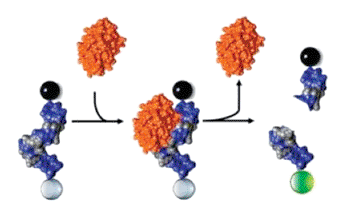Molecular Probe Lights Up Staph Infections
By LabMedica International staff writers
Posted on 17 Feb 2014
A novel chemical probe comprising a self-quenching fluorescently labeled oligonucleotide allows for the rapid, noninvasive detection of staphylococcal (staph) infections.Posted on 17 Feb 2014
To more easily identify sites of staph infection investigators at the University of Iowa (Iowa City, USA) created a novel molecular probe. The probe comprised a pair of deoxythymidines flanked by several 2′-O-methyl–modified nucleotides. Various chemical modifications rendered the molecule resistant to mammalian serum nucleases while leaving it susceptible to the action of staphylococcal micrococcal nuclease (MN). A fluorophore was attached to one end of the probe while a molecule that quenched the fluorescence was attached to the other. The presence of the quencher prevented emission of any fluorescent light.

Image: University of Iowa researchers have created a noninvasive probe that can detect a common strain of staph bacteria in the body. The staph bacteria are located via a light-emitting molecule (green), which is released when a bacterial enzyme (in orange) slices and separates the probe (shown in blue), shown in the illustration above (Photo courtesy of McNamara lab, University of Iowa).
The action of Staphylococcus aureus MN, an endo-exonuclease that digests single-stranded and double-stranded DNA and RNA, digested the probe and liberated the fluorophore from the suppressing effect of the quencher. As the probe was susceptible to digestion only by staph MN, the appearance of fluorescence pinpointed the site of bacterial infection.
The probe's fluorescence was activated in culture supernatants of S. aureus but not in culture supernatants of several other pathogenic bacteria. Systemic administration of this probe to mice bearing S. aureus muscle infections resulted in probe activation at the infection sites in an MN-dependent manner.
"We have come up with a new way to detect staph bacteria that takes less time than current diagnostic approaches," said senior author Dr. James McNamara, assistant professor of internal medicine at the University of Iowa. "It builds on technology that has been around a long time, but with an important twist that allows our probe to be more specific and to last longer. If the probe gets cleaved by serum nucleases, then our probe would be lit up all over the bloodstream. But since it is split only by staph nucleases, then we can pinpoint where the staph bacteria are active."
The investigators applied for US patent to protect use of the molecule in the fall of 2012, and plan to refine the probe so it can be detected deeper in the body and with catheter infections.
A paper describing the novel probe for staph infections was published in the February 2, 2014, online edition of the journal Nature Medicine.
Related Links:
University of Iowa













